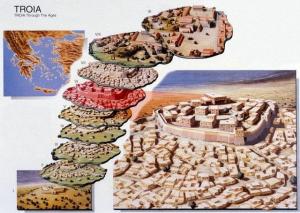Fall of Troy Anniversary
 The Trojan War was waged against Priam's city of Troy by the Achaean Greeks after Prince Paris of Troy took the beautiful Helen from her husband, King Menelaus of Sparta. The ten year war during the Late Bronze Age was one of the important events in Greek mythology and has been narrated through many works of Greek literature, most notably Homer's Iliad. Those who believe that the stories of the Trojan War derive from a historical conflict, date it to the 12th century BC, preferring the dates given by Eratosthenes as Spring 1194-1184 BC, which correspond to archaeological evidence of the destruction of Troy VII and the following Bronze Age collapse of Mycenaean Greek cities. 24th April 1184 BC has been the date selected to represent the legendary fall and destruction of Troy, Troia, over 3,200 years ago.
The Trojan War was waged against Priam's city of Troy by the Achaean Greeks after Prince Paris of Troy took the beautiful Helen from her husband, King Menelaus of Sparta. The ten year war during the Late Bronze Age was one of the important events in Greek mythology and has been narrated through many works of Greek literature, most notably Homer's Iliad. Those who believe that the stories of the Trojan War derive from a historical conflict, date it to the 12th century BC, preferring the dates given by Eratosthenes as Spring 1194-1184 BC, which correspond to archaeological evidence of the destruction of Troy VII and the following Bronze Age collapse of Mycenaean Greek cities. 24th April 1184 BC has been the date selected to represent the legendary fall and destruction of Troy, Troia, over 3,200 years ago.
The ancient story describes that after ten long years of seige warfare, the Achaean Greeks came up with a clever way to achieve their goal of breaking through the walls of King Priam's city of Troy. Led by a plan by Odysseus, the Achaeans made a show of burning their camp and sailing away for the island of Tenedos. However, just before they departed, the Greeks left a large wooden horse as a gift for the victorious people of Troy, a wooden horse* with forty Greek soldiers hidden inside. The Trojans opened their city gates and wheeled in their prize. As the Trojans celebrated their victory and the wine flowed freely, everyone finally passed out in a drunken stupor. This was when the hidden Achaeans emerged from their hiding place within the wooden horse and opened the city gates. The waiting Greek army rushed through the gates and pillaged the city, killing all the males, even the infants. All the younger women and girls were enslaved and anything of any worth was hauled away. Troy was then razed to the ground until there was nothing left but rubble and corpses. "Beware of Greeks bearing gifts" has been a saying passed down through history.
 British archaeologist and local expert Frank Calvert originally identified the hill of Hissarlick, on the Trojan plain of modern Turkey, in 1868 as the site of ancient Troy. Calvert suggested that the wealthy German businessman, adventurer and amateur archaeologist Heinrich Schliemann start digging for evidence of the ancient city. Calvert helped Schliemann, but it would be Heinrich Schliemann's name that would become world famous, as the pioneer of archaeology who discovered and revealed the site of ancient Troy. In the early 1870s, Schliemann found evidence of several ancient cities in the area from that period, and where he 'discovered' silver and gold vessels and jewellery, which he named 'Priam's treasure'. Troy's long history first surfaced in records as early as 3,000 BC, where cities were built on top of each other, with Troy having nine different city levels throughout its long tragic history.
British archaeologist and local expert Frank Calvert originally identified the hill of Hissarlick, on the Trojan plain of modern Turkey, in 1868 as the site of ancient Troy. Calvert suggested that the wealthy German businessman, adventurer and amateur archaeologist Heinrich Schliemann start digging for evidence of the ancient city. Calvert helped Schliemann, but it would be Heinrich Schliemann's name that would become world famous, as the pioneer of archaeology who discovered and revealed the site of ancient Troy. In the early 1870s, Schliemann found evidence of several ancient cities in the area from that period, and where he 'discovered' silver and gold vessels and jewellery, which he named 'Priam's treasure'. Troy's long history first surfaced in records as early as 3,000 BC, where cities were built on top of each other, with Troy having nine different city levels throughout its long tragic history.
*There is no mention of any wooden horse in Homer's epic Iliad, and in his Odyssey poem, he only gives a very vague description about a hippos (hippoi) made of planks. Although Hippos is Greek for horse, the ancient Greeks, Trojans and Phoenicians also referred to their ships as 'sea-horses' with many vessels having a horse's head as a 'figurehead' on the bow of their wooden ships. Also ancient siege machines, used to assault walled cities, were covered with damp horse-hides for protection, so we only read about a 'wooden horse' from the Roman historian Virgil in his Aeneid, Book II, translated into Latin many centuries after the event.